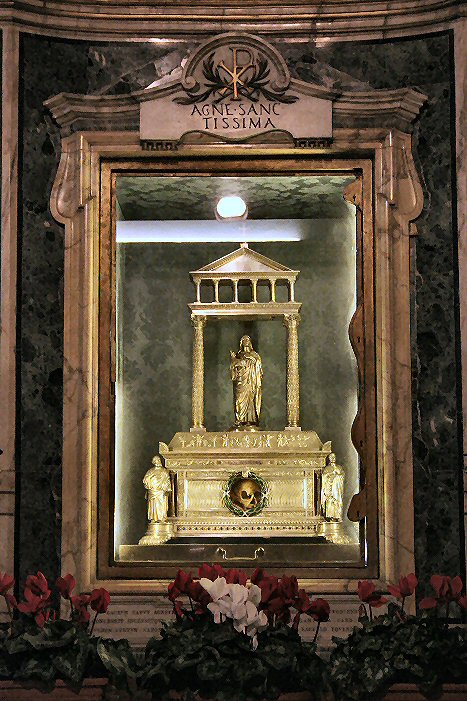 Did you know that St. Agnes of Rome, having two churches in Rome, was along with St. John the Baptist the only saint in the traditional Roman calendar not a member of the Holy Family, to have two feast days? Since the reform of the calendar, who now has only one day, alas, though the Baptist still has two.
Did you know that St. Agnes of Rome, having two churches in Rome, was along with St. John the Baptist the only saint in the traditional Roman calendar not a member of the Holy Family, to have two feast days? Since the reform of the calendar, who now has only one day, alas, though the Baptist still has two.
Agnes’s body is in her tomb in the ancient church named for her on the Via Nomentana while her skull is now at the place of her supposed martyrdom in the heart of Rome at the Piazza Navona. The skull came to that church during the reign of Pope Leo XIII who bequeathed it from the treasury of the Sancta Sanctorum.
Here is the text of the hymn from the Liturgia horarum for the "Office of Readings" with a brutally literal translation.
Igne divini radians amoris
corporis sexum superavit Agnes,
et super carnem potuere carnis
claustra pudicae.
Shining with the fire of divine love
Agnes overcame the gender of her body,
and the undefiled enclosures of the flesh
prevailed over flesh.
Spiritum celsae capiunt cohortes
candidum, caeli super astra tollunt;
iungitur Sponsi thalamis pudica
sponsa beatis.
The heavenly host took up her brilliant white spirit,
and the heavens lifted it above the stars;
the chaste bride is united to the
blessed bride chambers of the Spouse.
Virgo, nunc nostrae miserere sortis
et, tuum quisquis celebrat tropaeum,
impetret sibi veniam reatus
atque salutem.
O virgin, now have pity on our lot,
and, whoever celebrates your victory day,
let him earnestly pray for forgiveness of guilt
and salvation for himself.
Redde pacatum populo precanti
principem caeli dominumque terrae
donet ut pacem pius et quietae
tempora vitae.
Give back to this praying people
the Prince of heaven and Lord of the earth,
that he, merciful, may grant us peace
and times of tranquil living.
Laudibus mitem celebremus Agnum,
casta quem sponsum sibi legit Agnes,
astra qui caeli moderatur atque
cuncta gubernat. Amen.
Let us celebrate with praises the gentle Lamb,
whom chaste Agnes binds to herself as Spouse,
he who governs the stars of heaven
and guides all things. Amen.
We can note a couple things from this prayer. First, the reference to fire probably a description of Agnes’s death related in a metrical panegyric of Pope Damasus about how Agnes endured martyrdom by fire. On the other hand, St. Ambrose, when speaking of her death, speaks of martyrdom by the sword.
St. Augustine also speaks of Agnes in Sermons 273, 286 and 354.
St. Ambrose has a wonderful hymn about Agnes (no. 8) which is used now in the Roman Church for Lauds and Vespers.
St. Agnes, who was killed probably during the reign of the Emperor Diocletian in 304 (some say during the time of the Emperor Valerian (+260)) was buried by her parents in praediolo suo, on their property Via Nomentana where there was already a cemetery. This cemetery expanded rapidly after that, for many wanted to be buried near the famous martyr. The ancient cemetery, which grew in stages, expanded between the Basilica and the smalled, round Basilica of Constantia (a daughter of Constantine).
The actual basilica of St. Agnes on the Via Nomentana was originally constructed by Constantine, but it was probably reconstructed towards the end of the 5th c. Pope Symmachus (+514), and Honorius I (+638) restored the basilica Honorius adding the wonderful fresco of Agnes. It was worked on again n the 16th c. and the 19th, by Bl. Pope Pius IX. During excavations in 1901 the silver sarcophagus made by St. Pius V for St. Agnes and St. Emerentiana was discovered. It was found to contain the headless body of a young girl.






























Thank you, Father.
If you would permit a suggestion from an old latinophile whose mother’s name is Agnes …
LH:
Igne divini radians amoris
corporis sexum superavit Agnes,
et super carnem potuere carnis
claustra pudicae.
JZ (self-described as “brutally literal”):
Shining with the fire of divine love
Agnes overcame the gender of her body,
and the undefiled enclosures of the flesh
prevailed over flesh.
JG (suggested):
Shining with the fire of divine love,
Agnes overcame her body’s sex,
and the locked portals [claustra -nt.pl.]
of (her) chaste flesh [carnis pudicae]
conquered carnality.
[I changed “gender” to “sex,” because a word has a gender, but a person has a sex.]